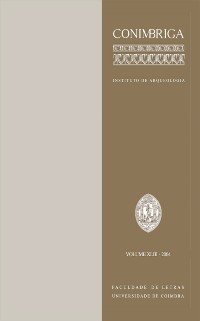Please use this identifier to cite or link to this item:
https://hdl.handle.net/10316.2/37699| DC Field | Value | Language |
|---|---|---|
| dc.contributor.author | Vilaça, Raquel | - |
| dc.contributor.author | Arruda, Ana Margarida | - |
| dc.date.accessioned | 2015-10-27T11:24:00Z | |
| dc.date.accessioned | 2020-09-22T20:53:16Z | - |
| dc.date.available | 2015-10-27T11:24:00Z | |
| dc.date.available | 2020-09-22T20:53:16Z | - |
| dc.date.issued | 2004 | - |
| dc.identifier.issn | 0084-9189 | - |
| dc.identifier.issn | 1647-8657 (digital) | - |
| dc.identifier.uri | https://hdl.handle.net/10316.2/37699 | - |
| dc.description.abstract | Quer no estuário quer no médio Tejo, a ocupação humana durante o Bronze Final foi intensa. Verifica-se que em ambas as áreas os espólios apresentam similitudes muito significativas, ainda que o tipo de implantação possa, em alguns casos, parecer distinto. A aparente descontinuidade geográfica, em termos de fixação de populações, entre as duas regiões tem sido colmatada por trabalhos recentes nos concelhos de Tomar, Abrantes, Mação e Sardoal, onde têm sido descobertos sítios ocupados no final da Idade do Bronze. Os dados que emanaram das escavações levadas a efeito na Cachouça, e de outros ainda em estudo no Alto Ribatejo, permitiram constatar que as relações entre as duas regiões permaneceram durante a 1ª metade do I milénio a. C., ainda que se admita que possam ter esmorecido. Com efeito, se é verdade que a densidade da ocupação orientalizante do estuário não tem paralelo no médio Tejo, também parece certo que parte do “pacote” oriental penetrou nele. A orientalização do interior norte peninsular, que atingiu, ainda nas margens do Tejo, Castilla la Mancha, e mais para Sul a Meseta e a Extremadura espanhola pode assim ser explicada por um percurso Oeste/Este, através do Tejo, em detrimento da explicação tradicional que lhe atribuía um sentido Sul/Norte, num trajecto que seguia o que veio a ser a via da prata. Os dados de um e de outro período são detalhadamente apresentados, no que se refere aos espólios e às tipologias de implantação, não se tendo desprezado os que a paleo-botânica e a paleo-zoologia também já forneceram. E as datações radiométricas obtidas nas duas regiões analisadas foram avaliadas e discutidas. Infelizmente, os dados referentes ao mundo funerário não abundam em qualquer das áreas, sendo aqui e agora evidente uma situação de clara invisibilidade tumular. Ainda assim, e mesmo que tenham sido apenas referidos, foram chamados à colação na discussão, sobretudo para evidenciar, também neste caso, a simetria das duas regiões em estudo quanto à simultaneidade de práticas funerárias distintas: a cremação e a inumação. | por |
| dc.description.abstract | The human occupation during the late Bronze Age in the estuary of the Tagus River, so as in his middle valley, was intensive. We have verified, in both areas, the same materials and the same topographical implantation, even we can observed some distinctive features in the later aspect. The geographical discontinuity between the two regions is only apparently. Archaeological works in Tomar, Abrantes, Mação e Sardoal have demonstrated the occupation of theses lands also in this period. The data obtained in the excavations of Cachouça, and in others sites of the Alto Ribatejo, allow us to conclude that the relationships between the two areas stay in order in the 1rst half of the I millennium B. C., even we can admitted that they had now lower importance. Effectively, the density of the orientalized Iron Age in the estuary is not comparable to what we could see in the middle valley. But, the true is that some parts of the oriental “package” are also here. So, we think that we can say that the process of orientalization of same interior areas of the Iberian Peninsula, verified in Castilla la Mancha, Meseta and Estremadura, may be explained by a trajectory West/East, across the Tagus river, and no by the traditional South/North thesis, across the future Silver Route. All the information’s about materials (ceramics, bronze and iron artefacts) and implantation typologies of the two periods are presented and discussed for both areas, and the paleo-botanical and paleo-zoological data are also analysed, so as the radio carbon dates. The data of the burial aspect are very poor in the estuary so as in the middle valley and a tumular invisibility have been showed. But it becomes clear, also in this case, the symmetry of both regions, in what concern to the funerary practices: cremation and inhumation are verified at the same moments. | eng |
| dc.language.iso | por | - |
| dc.publisher | Faculdade de Letras da Universidade de Coimbra | - |
| dc.rights | open access | - |
| dc.title | Ao longo do Tejo, do bronze ao ferro | por |
| dc.type | article | - |
| uc.publication.collection | Conimbriga vol. 43 | - |
| uc.publication.firstPage | 11 | - |
| uc.publication.lastPage | 45 | - |
| uc.publication.location | Coimbra | - |
| uc.publication.journalTitle | Conimbriga: Revista de Arqueologia | - |
| uc.publication.volume | 43 | por |
| dc.identifier.doi | 10.14195/1647-8657_43_1 | - |
| uc.publication.orderno | 2 | - |
| uc.publication.area | Artes e Humanidades | - |
| uc.publication.manifest | https://dl.uc.pt/json/iiif/10316.2/37699/234780/manifest?manifest=/json/iiif/10316.2/37699/234780/manifest | - |
| uc.publication.thumbnail | https://dl.uc.pt/retrieve/11499706 | - |
| item.grantfulltext | open | - |
| item.fulltext | With Fulltext | - |
| Appears in Collections: | Conimbriga | |
Files in This Item:
| File | Description | Size | Format | |
|---|---|---|---|---|
| ao_longo_do_tejo_do_bronze_ao_ferro.pdf | 3.05 MB | Adobe PDF |  |
Items in DSpace are protected by copyright, with all rights reserved, unless otherwise indicated.
